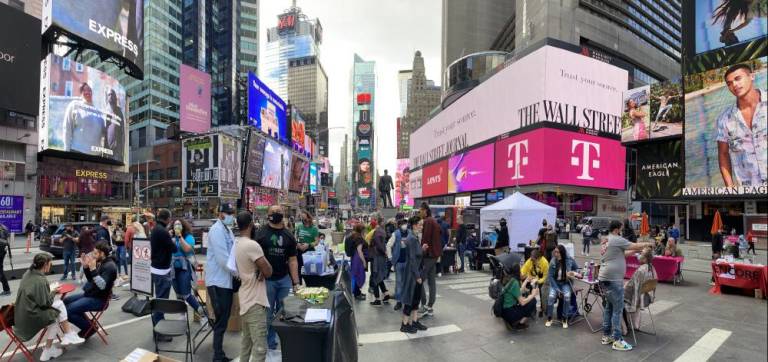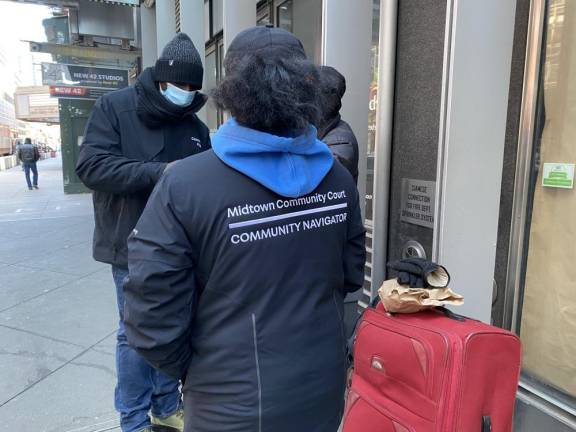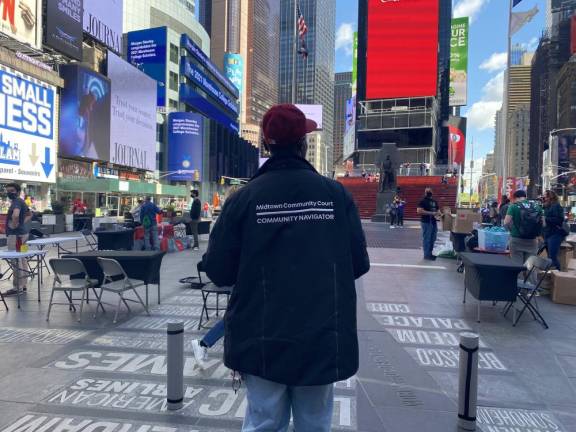Navigating ‘Quality of Life’ Crimes in Times Square
A new outreach effort in the area addresses problems that inhibit the return of workers and tourists



In the depths of our winter of COVID-19, Lauren A. Curatolo and her colleagues ventured into a disturbingly derelict Times Square to find and help some of the people living on its streets, which in better times have been thought of as the crossroads of the world.
“It was so cold,” she recalled of those days last January.
Most obviously, their mission was to stem a visible and worrisome rise of drugs, crime and harassment that was fueling a sense of urban disorder in New York, with Times Square at the, yes, crossroads.
But more subtly they were trying to repair an unfortunate side effect of the effort to reduce the use of police and the courts to suppress problems that were really about mental health, narcotics abuse and homelessness.
Before these efforts, social services to address addiction, mental illness and homelessness were often delivered in conjunction with arrest and criminal prosecution. Legal Aid defenders often served double duty as informal social service intake officers.
But as bail reform and other steps reduced encounters with the criminal justice system, “there was no proactive strategy to get those services to people on the street,” said Tom Harris, President of the Times Square Alliance, the business district covering the neighborhood.
So the Alliance turned to Curatolo, Project Director at the Midtown Community Court and a former public defender. The Alliance was concerned that rising drug overdoses and other “quality of life” crimes would inhibit the return of workers and tourists to Times Square.
“They asked us to envision an intervention that doesn’t involve NYPD,” Curatolo recalled.
So she joined forces with two other social service providers, Fountain House, which works with people suffering from mental illness, and Breaking Ground, which helps those experiencing homelessness. The three worked together to send what they call community navigators into Times Square with offers of services, instead of waiting for the problems to turn into a crime and an arrest that would bring the person to the services.
“How can we get you all the things you need so you don’t need to steal the thing from Duane Reade,” Curatalo sums up. “The criminal process is not the space for you to become healthy again.”
“I Get Chills”
The need for this has become ever more apparent in recent days.
The return of international travelers, as the border reopens November 8, is eagerly awaited by hotels, restaurants, theatres and other businesses trying to restart from the pandemic.
But how quickly they decide it is OK to actually come – to say nothing of when local office workers will return – is at least in part dependent on getting past several horrifying recent incidents in the area, including a woman injured when she was shoved against a subway train and the death of Maria Ambrocio, a nurse who was knocked over by a mentally ill assailant fleeing down 39th street with a cellphone he had just stolen from someone else.
“I get chills when I think about Maria Ambrocio,” said Tom Harris, “and that could be anyone. The system failed Maria and the system failed that person who isn’t even aware of what he did. We need to do better.”
Meaningful Interactions
The outreach Lauren Curatolo and her colleagues began in January, funded by the Times Square Alliance, clearly has not solved all the problems in the neighborhood. But it is working well enough that the de Blasio administration agreed to pick up the costs beginning last July.
Since January, community navigators have had what they describe as 349 meaningful interactions with people needing some form of service, from a meal to a bed to drug treatment. That may not seem like a lot. But Harris points out that the actual number of people at any given time living or lingering on the streets of Times Square is generally less than three dozen.
Harris notes that while the police shouldn’t be used as social workers their presence remains vital. He praised the city for deploying an additional 120 police officers each day “to restore a sense of order to the area.”
“We Need to be Precinct-Based”
The relationship between the NYPD and the delivery of social services to those in need is still a work in progress, Curatolo said. As a companion to the program of outreach on the streets, she has also begun a program to intercept those who are arrested and brought to local precincts.
In the old days, many of these people would have gone to central booking downtown. This was where most social service intervention occurred.
But under the reformed procedures many of these offenders receive a so called “desk appearance ticket” at the precinct and are released pending a court appearance without ever going downtown.
The obvious solution is “we need to be precinct-based,” Curatolo suggested. “We should be in there as someone is leaving the precinct.”
But this has been “harder to get off the ground,” she says, than the street outreach. A combination of COVID-19 and NYPD rules has made it hard to operate from inside the precincts.
“Right now we are operating for NYPD to call us, so we can be responsive as someone is leaving. We haven’t been able to be physically present.”
This moment can feel rife with angst and anguish as New Yorkers worry about the city’s economic and social recovery. But Curatolo says she is encouraged that the crisis of the last year is producing pilot programs like the Times Square navigators that take a new look at problems that were well known but not well addressed, like getting proper services to the mentally ill before their problems become crimes.
“I hope this is a time when everyone can say ‘lets keep this urgency alive.’” Curatolo says. “I don’t think that’s a bad thing. I’m excited for what that can mean.”
“The system failed Maria [Ambrocio] and the system failed that person who isn’t even aware of what he did. We need to do better.” Tom Harris, president of the Times Square Alliance, on the nurse who died after being knocked over by a mentally ill assailant